Hanal Pixán is the Yucatec Maya’s version of Dia de los Muertos, or Day of the Dead, and is a three day celebration occurring between October 31st and November 2nd. Its purpose is to commemorate the link between the living and the dead by honoring friends and relatives who have passed away. They do this by building the dead altars and offering them their favorite things from life.
The first day of the celebration, October 31st, is dedicated to children’s souls. The second day, November 1st, is dedicated to the adult souls. The third, November 2nd, is dedicated to all the adult, children and Lonely Souls.
Lonely souls are the ones who do not have family or friends to build altars to honor them. Yucatecans believe these souls become sad and attempt to make them happy by placing altars at the corner of their own homes dedicated to these sad souls. They then call loudly for the Lonely souls to come and get the offerings set forth to cheer them up in the afterlife. It is really an extraordinary example of kindness and humanity toward others, even in their afterlife.
In the recent years, Merida has held a public festival dedicated to Hanal Pixán, called Paseo de las Ánimas. to further commemorate and celebrate those who we miss in death. They hold activities every day of the celebration throughout the city but the biggest day of events is the first day of celebration, October 31st.
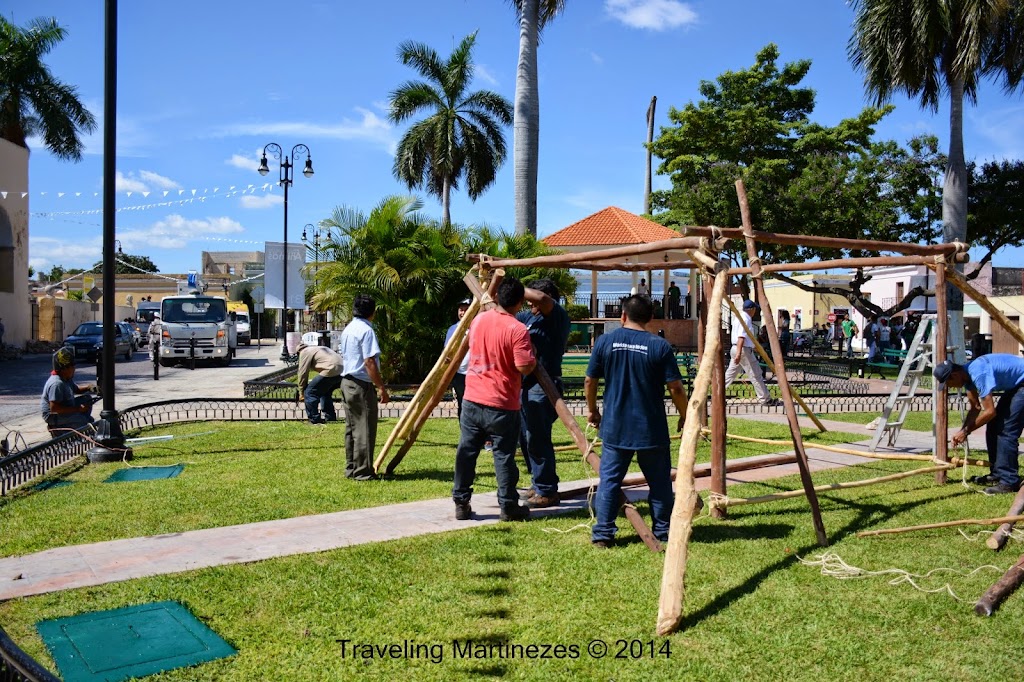 OCTOBER 30TH, 2014 – PREPERATION FOR PASEO DE LAS ÁNIMAS IN MÉRIDA
OCTOBER 30TH, 2014 – PREPERATION FOR PASEO DE LAS ÁNIMAS IN MÉRIDAAlthough the activities officially did not began until October 31st, preparation starts far earlier than that. As we roamed the various neighborhoods of Merida the day before we saw several parks getting ready for the festivities.
We do not mean just streamers and signs being hung but they were receiving mini facelifts; benches, fences and concrete walks were painted, rod iron fences were repaired and painted, altars and stages were erected throughout the city. Large crews of workers were out welding, constructing, painting, trimming, raking and sweeping.
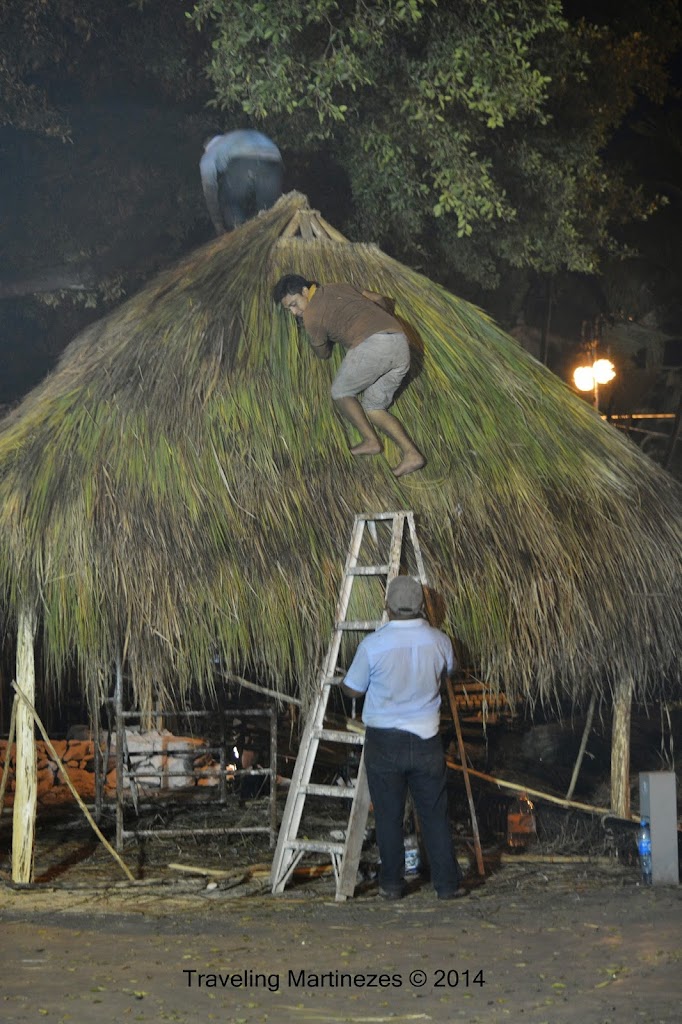
In the main park, el centro, teams worked all night erecting over 200 huts to house the Hanal Pixán altars the following day. Barefoot men, in the glow of the city night, shimmied up the poles and back down again, carrying palm fronds with them as they climbed. They assembled each palapa hut one by one, literally one frond at a time.
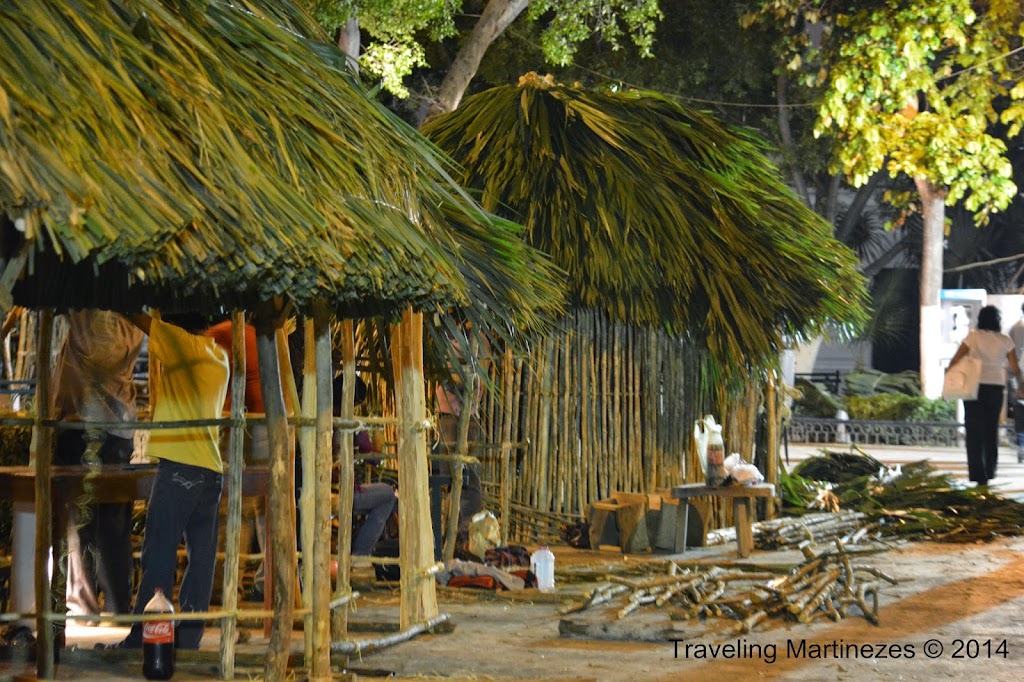
OCTOBER 31ST, 2014 – MORNING ACTIVITIES AT PASEO DE LAS ÁNIMAS IN MÉRIDA
UNIVERSIDAD AUTÓNOMA DE YUCATÁN (UAYD)
Location: SW corner of Calle 57 and 60, Merida
Time: We got there at 9:30 (9:00-10:00)
As we walked we passed UAYD. There were tons of people coming and going from the school so we thought we would check out what was going on. Our daughter plans on attending this university between high school and college in a gap program, to teach English in the neighboring town of Piste, so I wanted to take pictures of the inside, anyways, to show her.
As we entered, we saw they were having their own Hanal Pixán celebration, with each degree department presenting their own altar. There were quite a few spectators enjoying the exhibition. We walked around and admired each one of the handcrafted altars.
The students seemed thrilled at all the attention their hard work was getting, a few even photobombed a photo I took. UAYD is definitely worth a stop if you are in Merida, especially for Paseo de las Ánimas.
EL CENTRO, PLAZA GRANDE or PLAZA DE LA INDEPENDENCIA
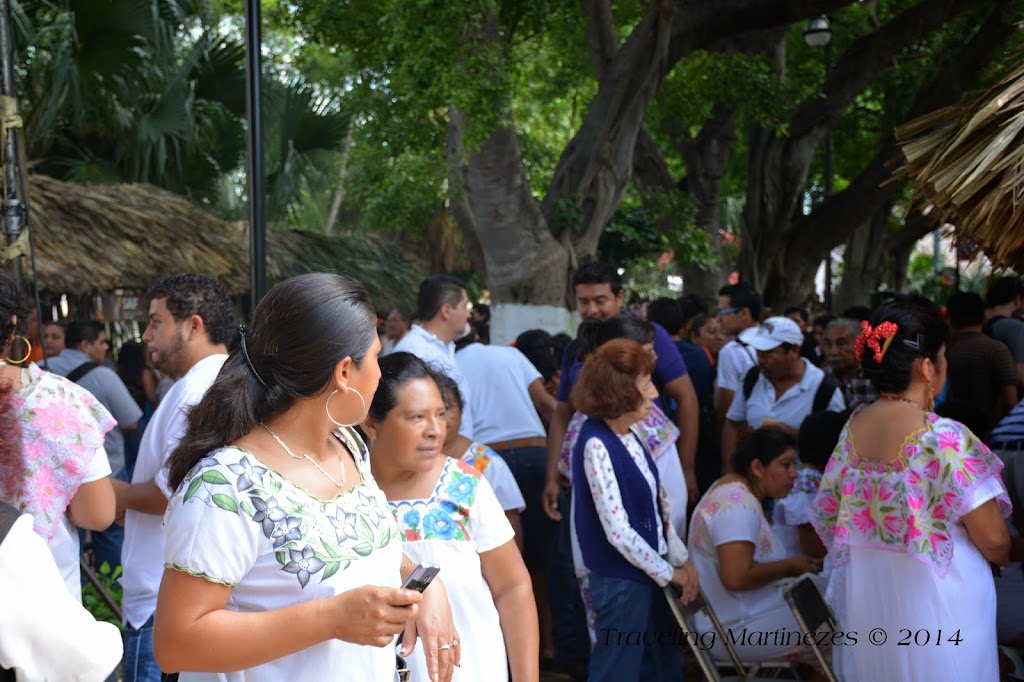 Location: Block formed by Calles 60, 61, 62 and 63, Merida
Location: Block formed by Calles 60, 61, 62 and 63, MeridaTime: We got there before 10:00 (10:00-11:00)
After seeing the altars at UAYD, we hurried to Plaza de la Independencia to insure we did not miss the altars there. I was absolutely astonished by how busy the plaza was! It was packed with participants and spectators, alike.
As we entered the park from Calle 60 and 61, a large group of women donned in hair nets, aprons and gloves layered banana leaves for the traditional pibil to be sold or given away at some point during the event.
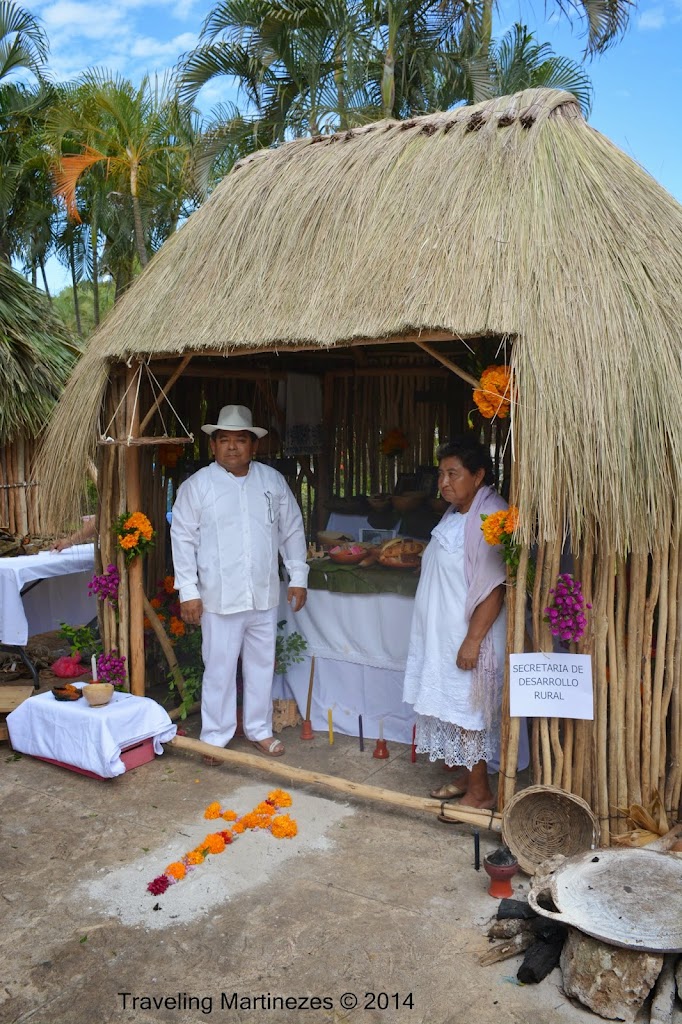
Just passed the women cooks began the palapa huts housing the altars. Each one was created and displayed by a different town, village or organization.
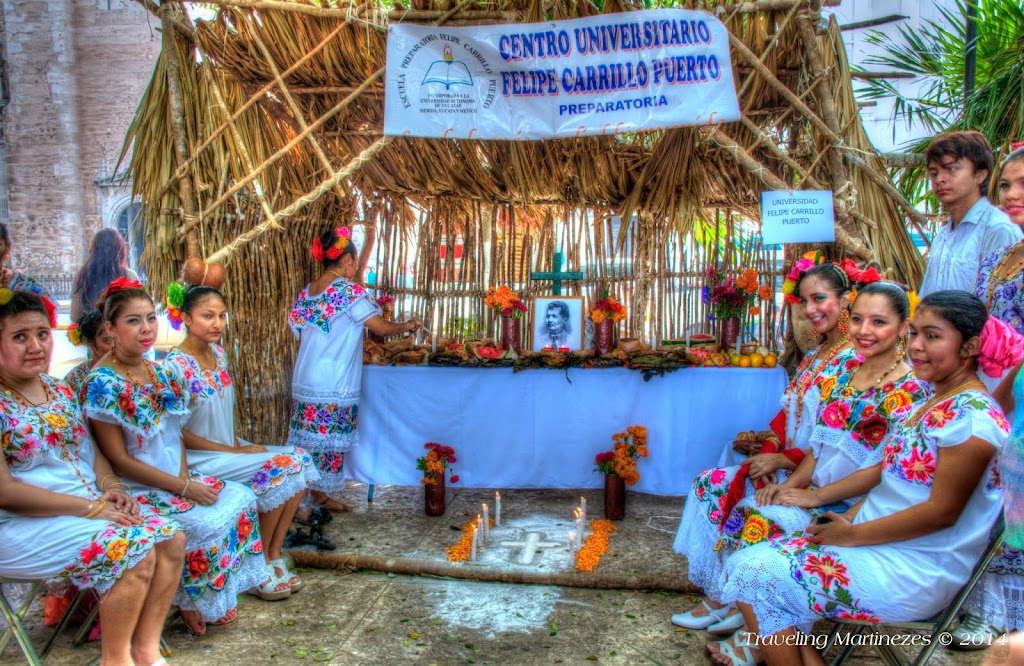
The huts were a variety of sizes, shapes, wall styles and even roof styles; they really exhibited the slight regional differences between construction styles, you would never notice as easily if they were not right next to one another.
The altars were erected, proudly labeled and covered in candles, photographs and offerings of ancestors’ favorite foods, drinks, things and flowers.
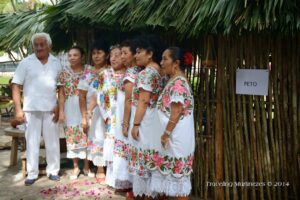
Most occupants of the huts were dressed in traditional regalia; the women wore huilpil’s and the men guayaberas, both made of local cotton.
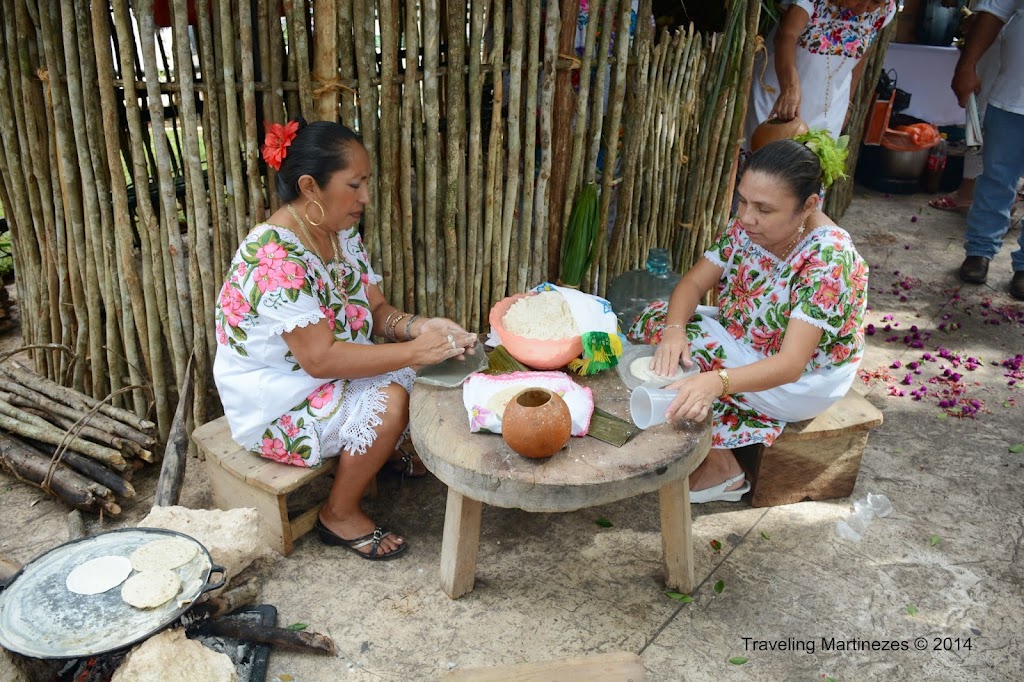
Outside of a few huts, women sat making tortillas in the traditional fashion with their bare hands; they would grab a ball of masa from the bowl and pat it into a perfect flat circle, the size of a Mayan woman’s hand, on a piece of wax paper. They would then cook it on a comal warmed by an open fire.
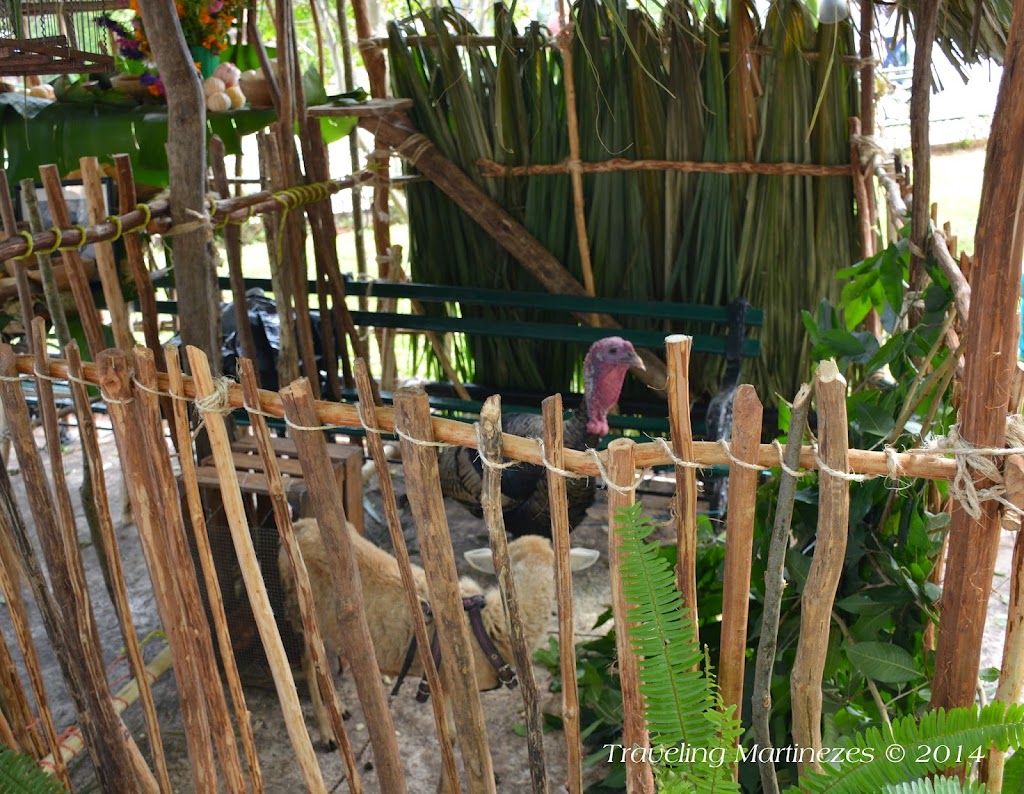
Some displays had animals: chickens, finches, goats, all representing favorite pets or foods of those family members who have passed.
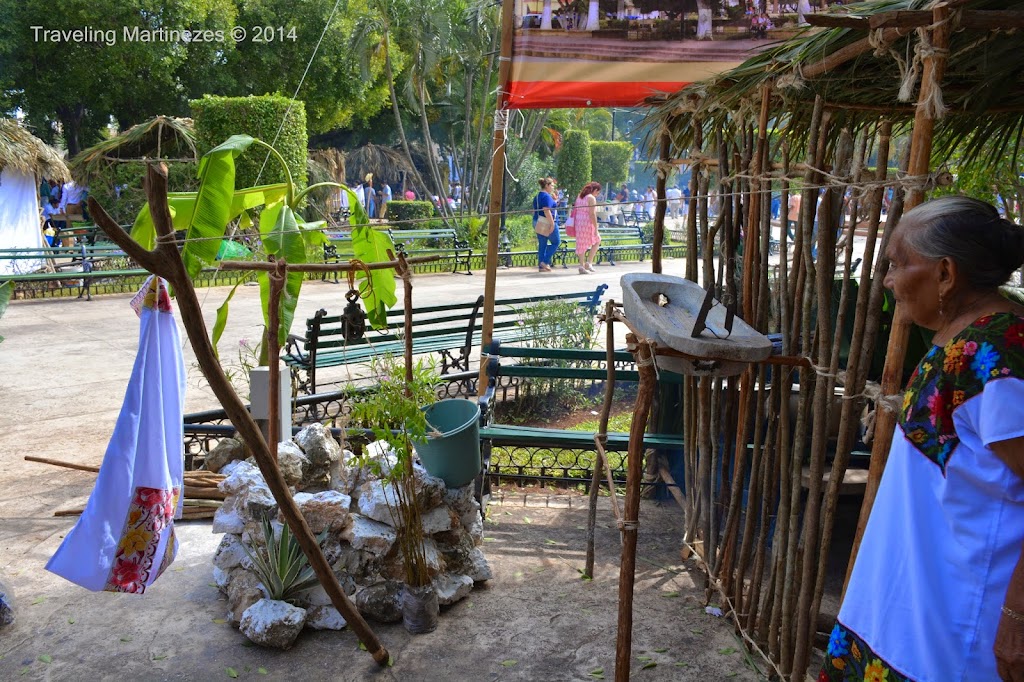
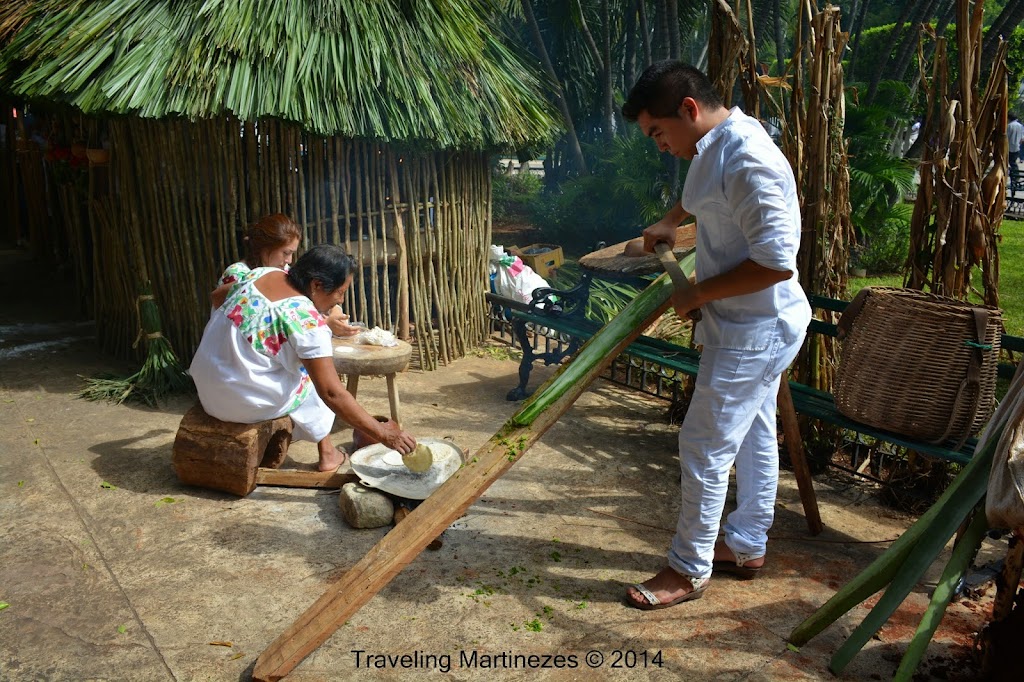 Others had wooden sinks and faux wells set up outside to replicate their normal kitchen, in use even today. Maya’s kitchens historically and contemporarily are set up in a central courtyard, an extended family lives on a single communal family lot and share a single garden, well, orchard, stone lot line and sink but live in individual nuclear family homes on the lot.
Others had wooden sinks and faux wells set up outside to replicate their normal kitchen, in use even today. Maya’s kitchens historically and contemporarily are set up in a central courtyard, an extended family lives on a single communal family lot and share a single garden, well, orchard, stone lot line and sink but live in individual nuclear family homes on the lot. At another hut, a gentleman juiced sugarcane in the traditional fashion. The participants were putting on a human exhibit of the daily lives of contemporary and historic Mayas alike.
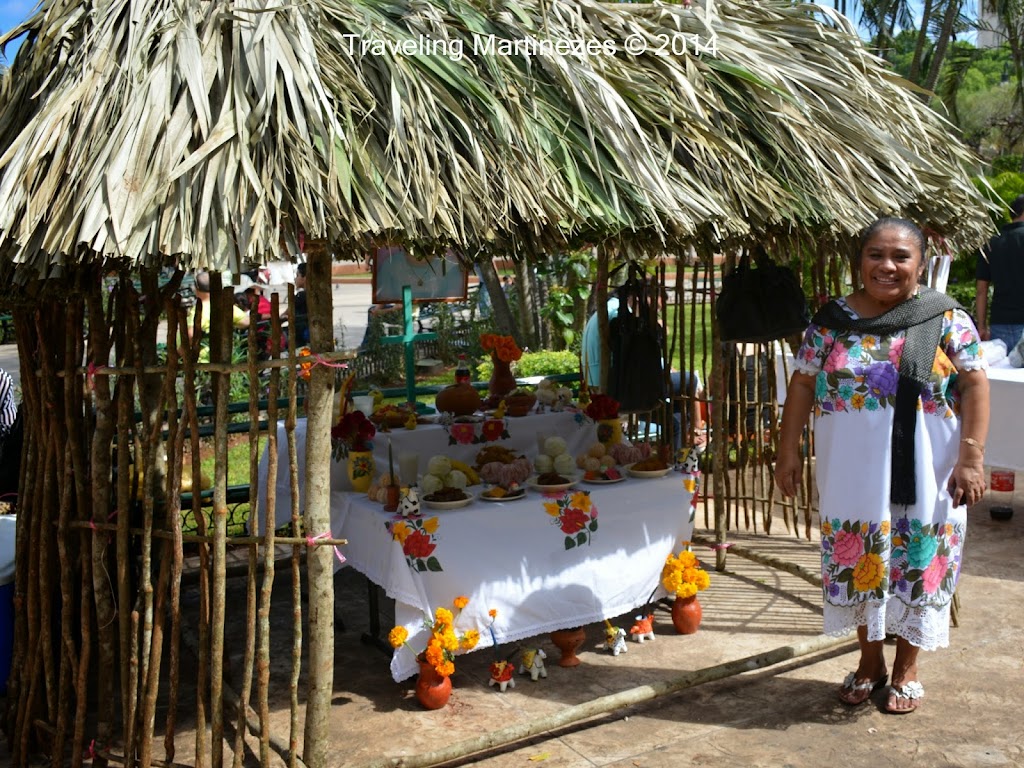
Most stood proudly next to their handiwork with beaming smiles. They seemed happy to have others remembering their family members and appreciating their celebration of those they had lost. 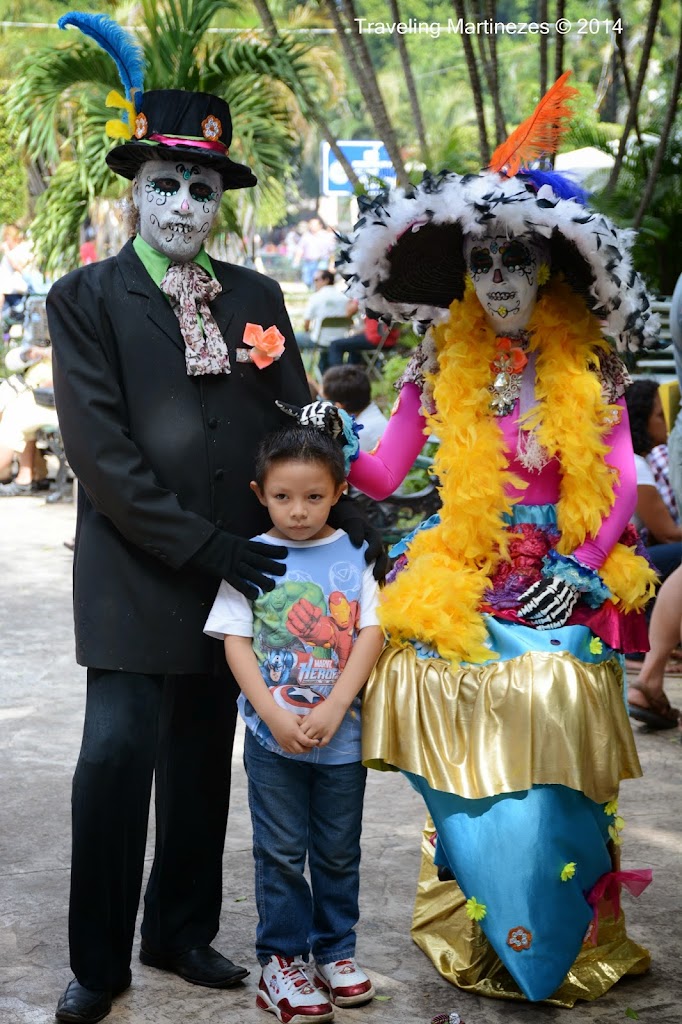 People were dressed as the male and female skeletons, El Katrin and La Catrina respectively; both symbols are strongly associated with Dia de los Muertos. Some performers were dressed as these skeletons and offered to let you take pictures with them for a tip; others were advertising for businesses by offering free pictures.
People were dressed as the male and female skeletons, El Katrin and La Catrina respectively; both symbols are strongly associated with Dia de los Muertos. Some performers were dressed as these skeletons and offered to let you take pictures with them for a tip; others were advertising for businesses by offering free pictures. 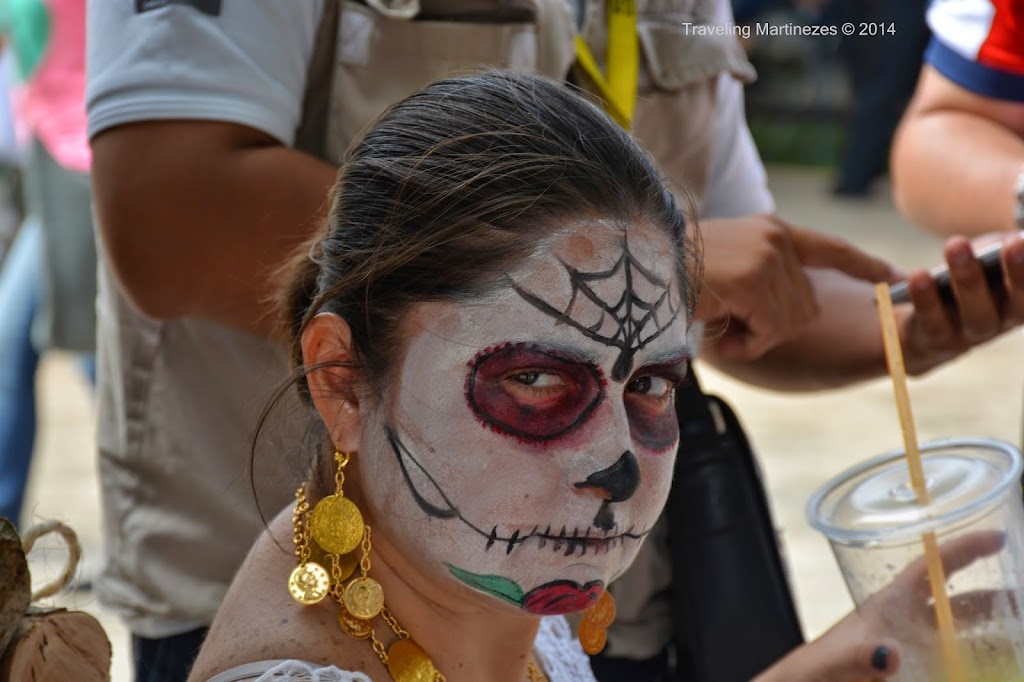
Many spectators had their faces painted like sugar skulls to participate in the day’s activities, often creating an interesting dichotomy between ancient and modern. It truly shows how cultures adapt, change and meld to fit current norms.Seeing the altars was an absolutely amazing experience, my only regret – not taking the kids with us! I really had no idea how huge it was going to be and how much effort would be exerted by all involved to make this such a spectacular event. Imagine too, this was just the first scheduled event of the day!
OCTOBER 31ST, 2014 – EVENING ACTIVITIES AT PASEO DE LAS ÁNIMAS IN MÉRIDA
Performances went on throughout the city all evening; Plaza de la Independencia, Arco de San Juan, Esquina del Diamante, Ermita de Santa Isabel, Jardín Botánico de la Ermita and Cemeterio General, all had hourly activities scheduled throughout the evening, from 18:00-22:00. There was so much going on we really had to look the list over, deciding which we wanted to see the most and which we could miss all while considering if we could feasibly get to and from them in the allotted time.
PLAZA DE LA INDEPENDENCIA’S
or EL CENTRO, PLAZA GRANDE
Location: Block formed by Calles 60, 61, 62 and 63, Merida
We started at el centro, Plaza Grande, Plaza de la Independencia or Zocalo de Merida, at about 17:30 to watch the all-female Maya band “Las Maya Internacidad”.
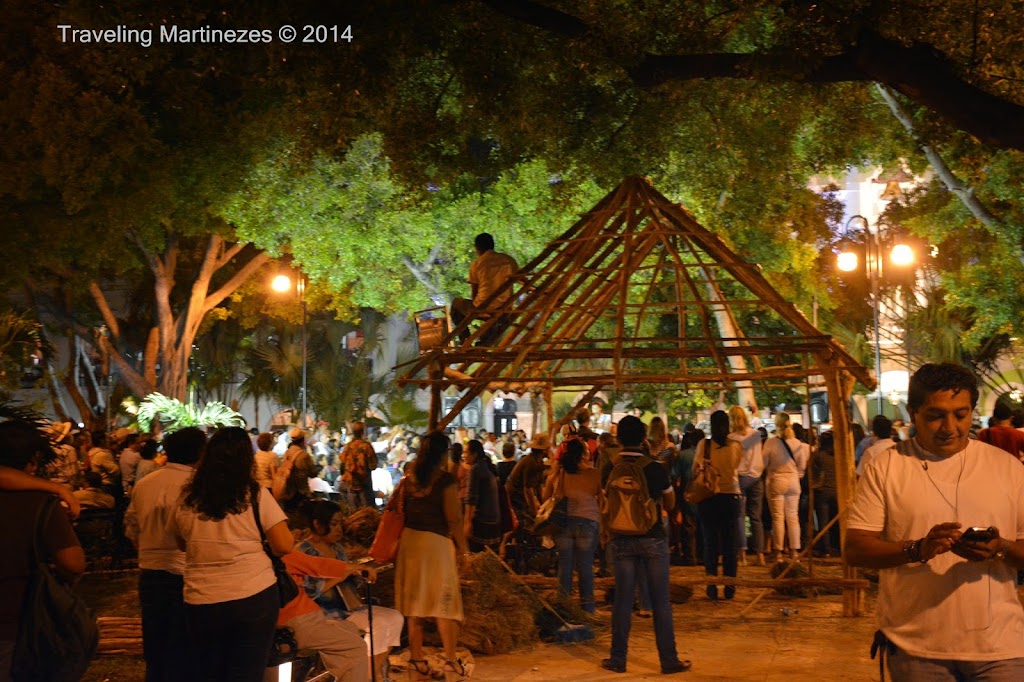
Everyone was packed in to see the ladies preform, yet immediately behind the large crowd men were working to deconstruct the palapas that had housed the altars and offerings just hours before; making it a very interesting scene from the back of the crowd, where we were standing.
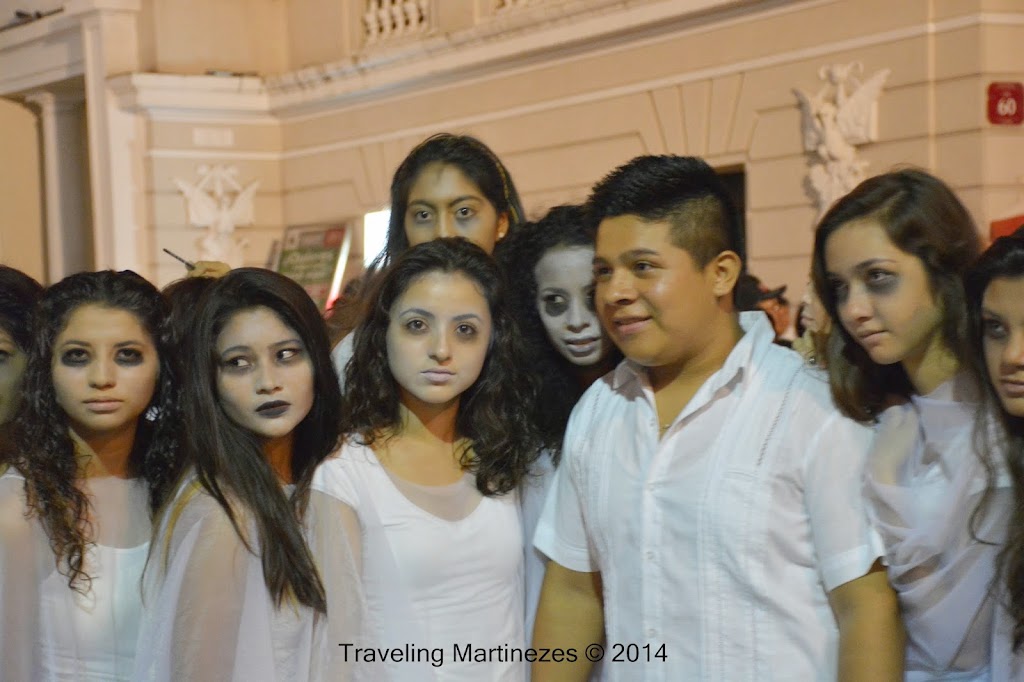
We watched for a while and around 18:20 we moved onto the street, where we noticed a parade getting ready to commence. A gray coffin was getting ready to be carried by several people through the streets of Merida.
Waiting to follow behind were people, the ‘souls’, dressed in all white or all black with faces painted to match their clothing. Together they formed the Cortejo Fúnebre, the Funeral Procession, which was heading to Parque de Santa Anna.
We were trying to get to San Juan Park to see the Mayan rapper named Pat Boy perform on the stage there, so unfortunately we could not follow the parade.
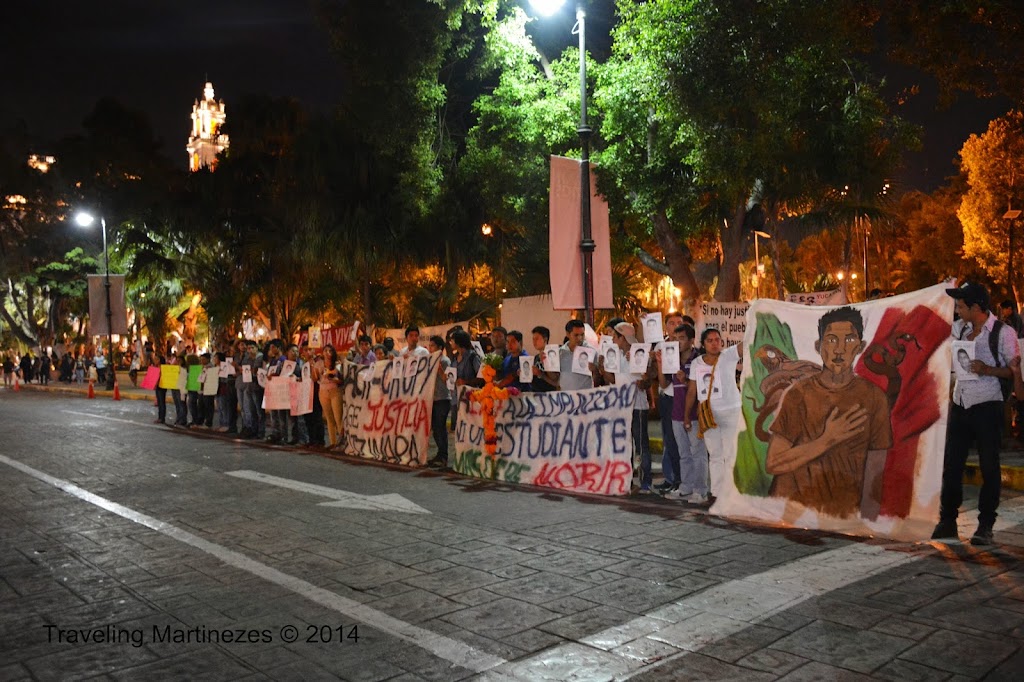
Before we left Plaza de la Independencia a group of people began protesting the 43 Ayotzinapa students who had disappeared. I could barely translate what they were saying over the blow horn but pain knows no language barrier because it gave me chills, the pain I felt coming from that group of people.
As they stood holding pictures of the missing and picket signs, they began listing the names of the young men who disappeared that day. A video began to be projected on a screen behind them; black and white sketches of each missing student flickered on the screen for a moment before it flashed to the next one’s picture.
Not one official, police or otherwise, attempted to stop them or even tried to control them, they did not need to it was a very controlled protest. The protestors were peaceful, organized and simply demanding to be heard and were achieving their goal as a large crowd continued to gather around them, taking in what they were presenting.
SAN JUAN PARK’S STAGE
Location: Corner of Calle 64 and Calle 69A, Merida
When we left, we followed a large crowd a half mile to San Juan Park; it was pretty cool traveling amidst a huge mass of people slowly moving in unison along the old narrow sidewalks of Merida.
We arrived at Iglesia de San Juan Bautista, the crowd was sparse because no one was currently performing on the church’s stage; it had taken so long for us to get to the park, we had missed Pat Boy rap. Kitty corner, at the Arch’s stage, though there was a performance going on.
There were several food carts parked at Parque de San Juan in between the church and altar. We decided to grab a couple of tortas and went to the busiest cart. The family who worked it had it set up quite well, complete with a television, eat-at-counter, plastic tables and chairs for customers to sit at; it was pretty nice for a wheeled cart, almost a complete mobile restaurant.
They lacked a working sink and dealt with it by covering their plates with plastic bags, similar to our fresh produce bags at the supermarket. They would simply throw away the dirty used bag and replace it with a new one, presto clean dish in an instant with no water needed. The mother and daughter-in-law dealt with the customers while the son/husband prepared the orders.
None of the seats were available when we first arrived; it was so busy. We waited and grabbed the first table that became available. Once we got a table, we ordered three poc chuc tortas ($15MXN each) and two glass bottle sodas ($10MXN each). The daughter-in-law brought us our sandwiches and we ate our delicious meal. The mother handled the bill calculations and collected our money totaling $65MXN, before we rejoined the festivities.
Still no performances had begun at Parque de San Juan so we decided to cross the street, toward the stage located at the base of the San Juan Arch. The city had constructed the Arch’s stage facing away from the park’s stage, so the stages sat back to back; I’m sure the design was to insure the two would not interfere sound wise with each other, despite their close proximity.
SAN JUAN ARCH’S STAGE
Location: Under the San Juan Arch at the corner of Calle 64 and Calle 69A, Merida
San Juan Arch’s stage took up the entire width of the street, leaving only the sidewalks open for the large mass of people to move past the stage, so they would be able to see the performers.
We became stuck in a human funnel because of this setup, the huge glob of people, we were in, was forced down in size to a two-person wide line with one sidewalk going in and the other heading out, two people by two people we squeezed through at a time.
It was quite slow but interesting and actually funny at times; when you are the Jolly Green Giant of the mob, as I was, it is strangely less intimidating. At one point, a short, young woman of Maya descent literally held onto my waist and let me lead her out of the chaos.
On the other side of the stage or arch, you could actually see the front of the group, Ballet Folclorico del Ayuntamiento, performing on the stage, which stood at most two feet high.
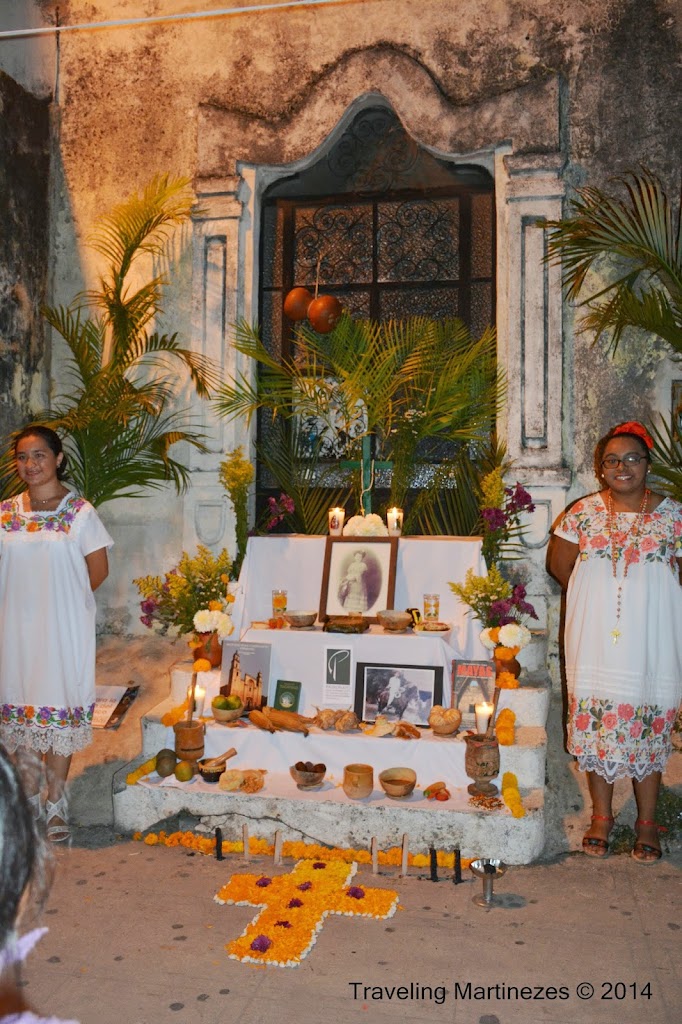
Passed the crowd watching the dancers, there were altars set up. Homeowners along the street displayed their family altars proudly in front of their homes. Coming to the end of several beautiful altars we decided to begin to head back through the congestion.
We funneled through the narrow exit; squeezing past the short stage and literally bursting out onto the street in front of San Juan Park and Bar San Juan. Tired, thirsty and needing a restroom, we went in and had a drink before we committed to the long walk back to the hotel.







 Others had wooden sinks and faux wells set up outside to replicate their normal kitchen, in use even today. Maya’s kitchens historically and contemporarily are set up in a central courtyard, an extended family lives on a single communal family lot and share a single garden, well, orchard, stone lot line and sink but live in individual nuclear family homes on the lot.
Others had wooden sinks and faux wells set up outside to replicate their normal kitchen, in use even today. Maya’s kitchens historically and contemporarily are set up in a central courtyard, an extended family lives on a single communal family lot and share a single garden, well, orchard, stone lot line and sink but live in individual nuclear family homes on the lot. 






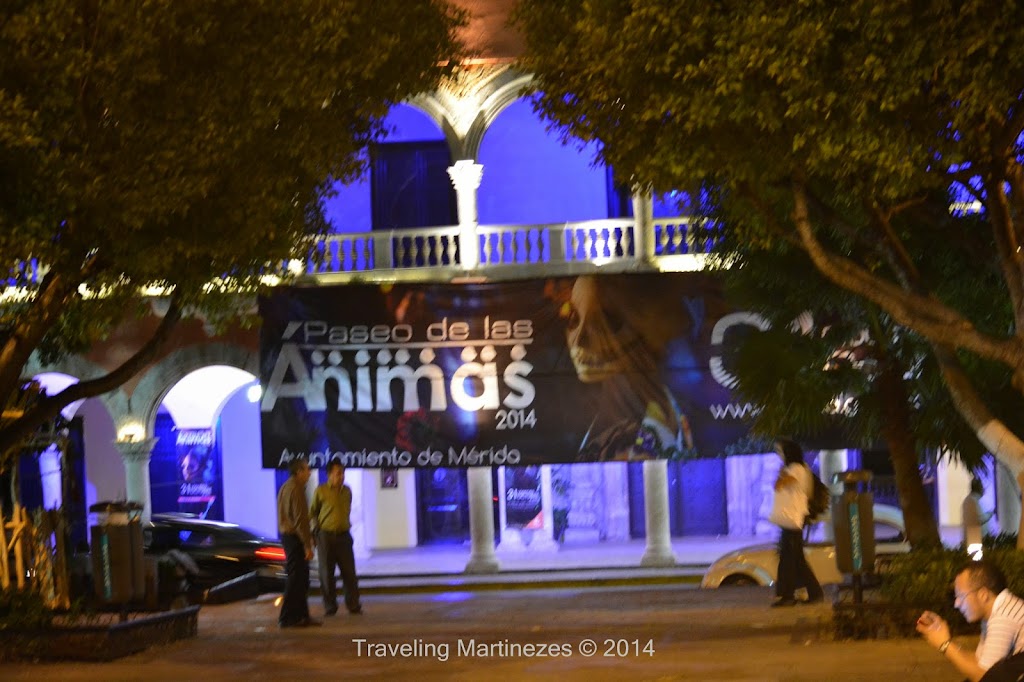

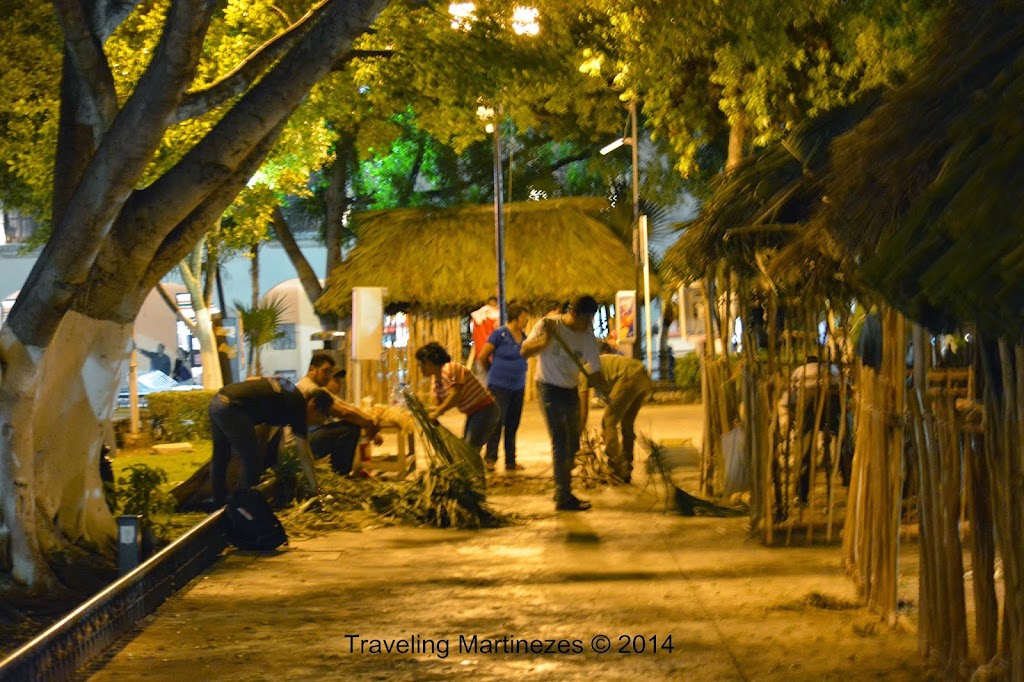
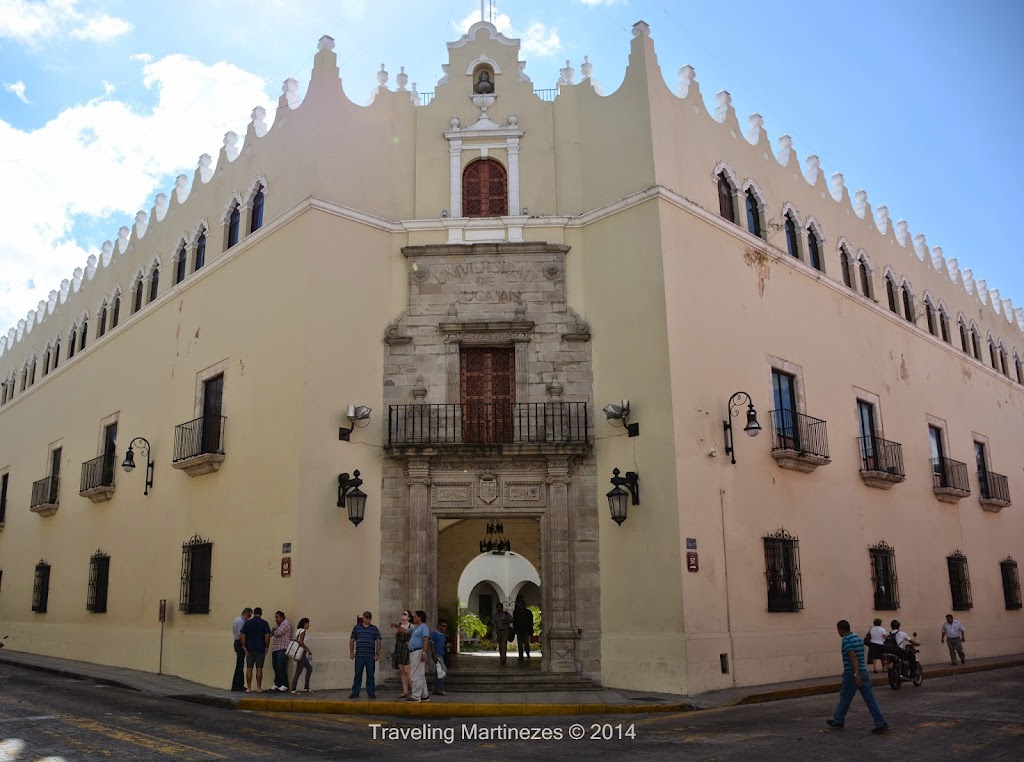
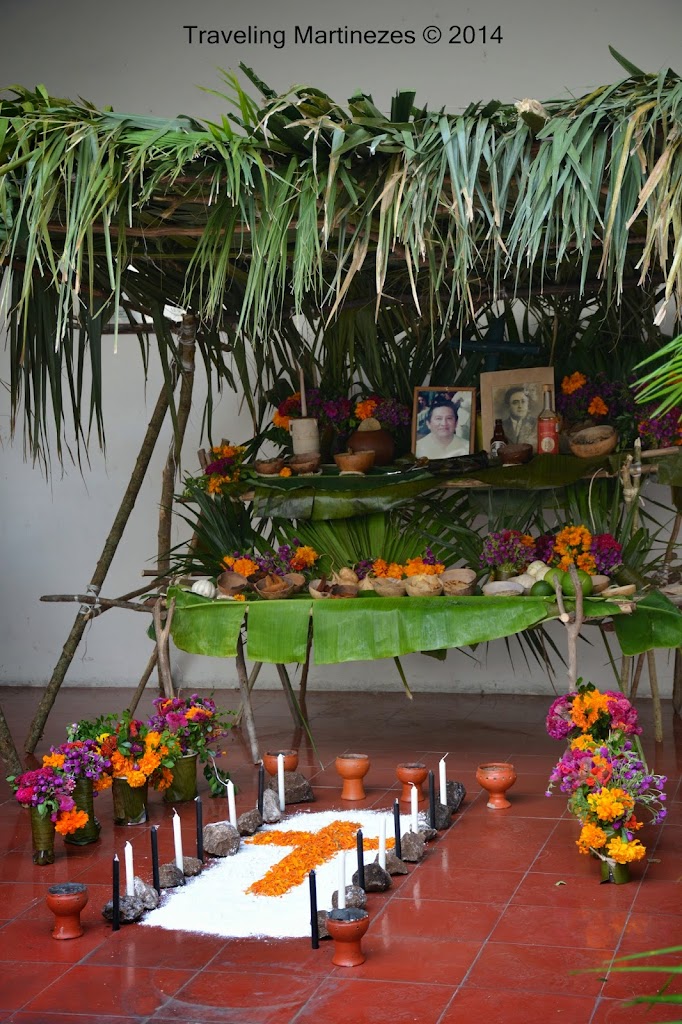
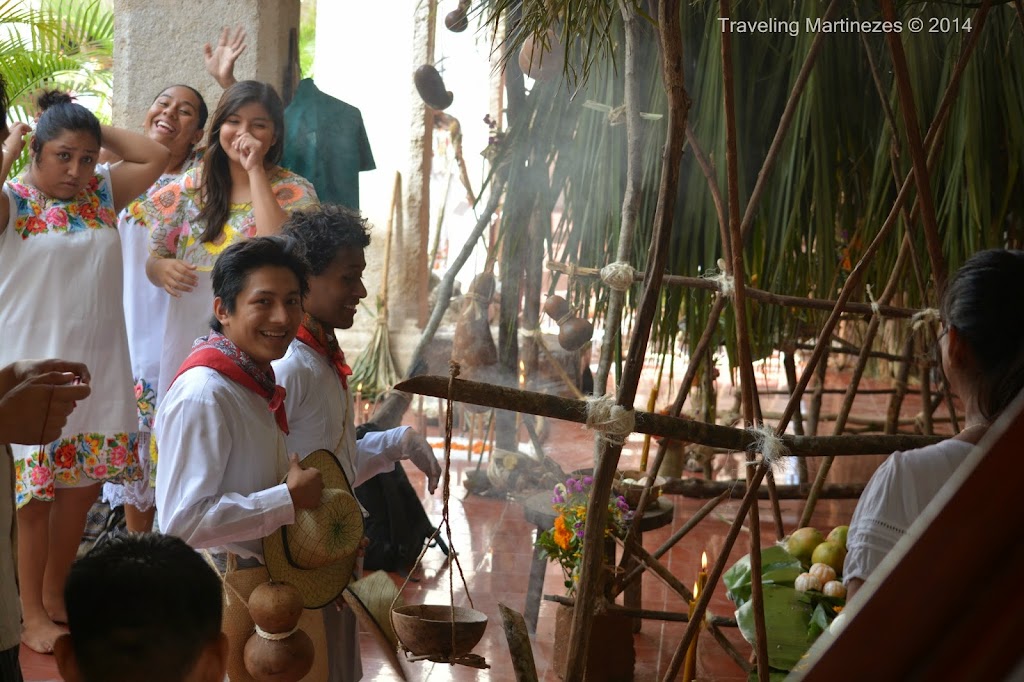

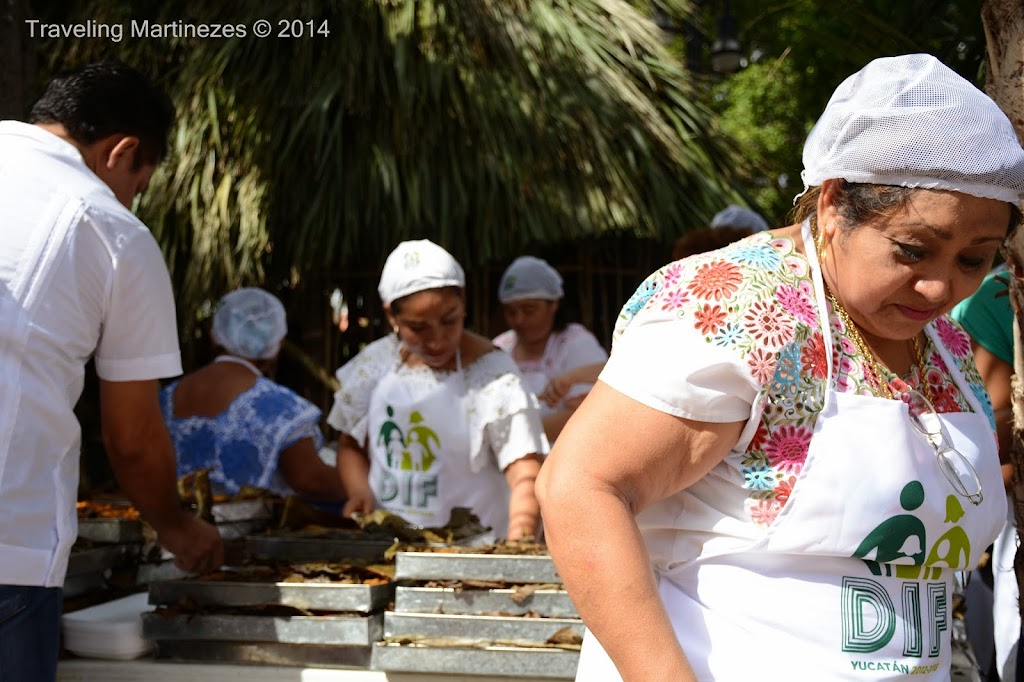
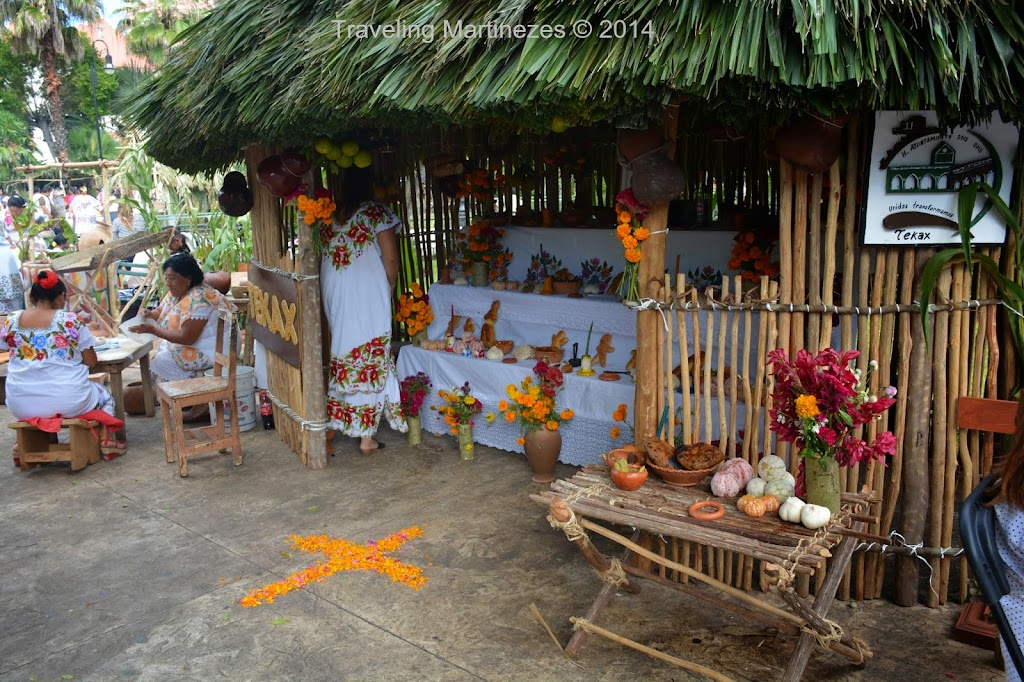
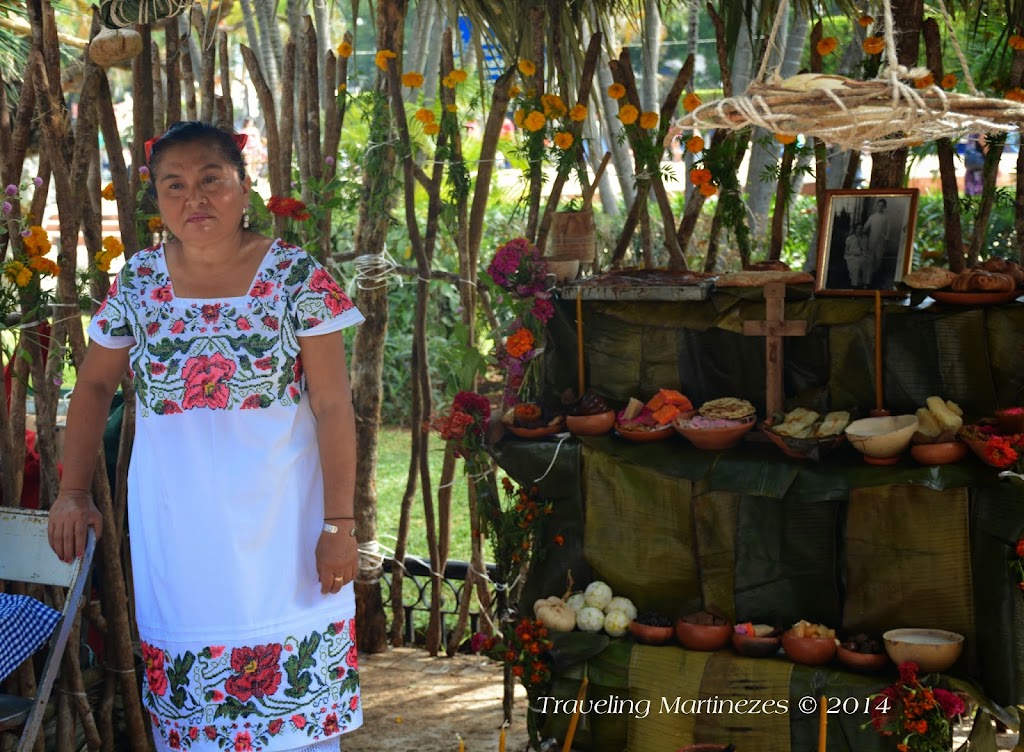

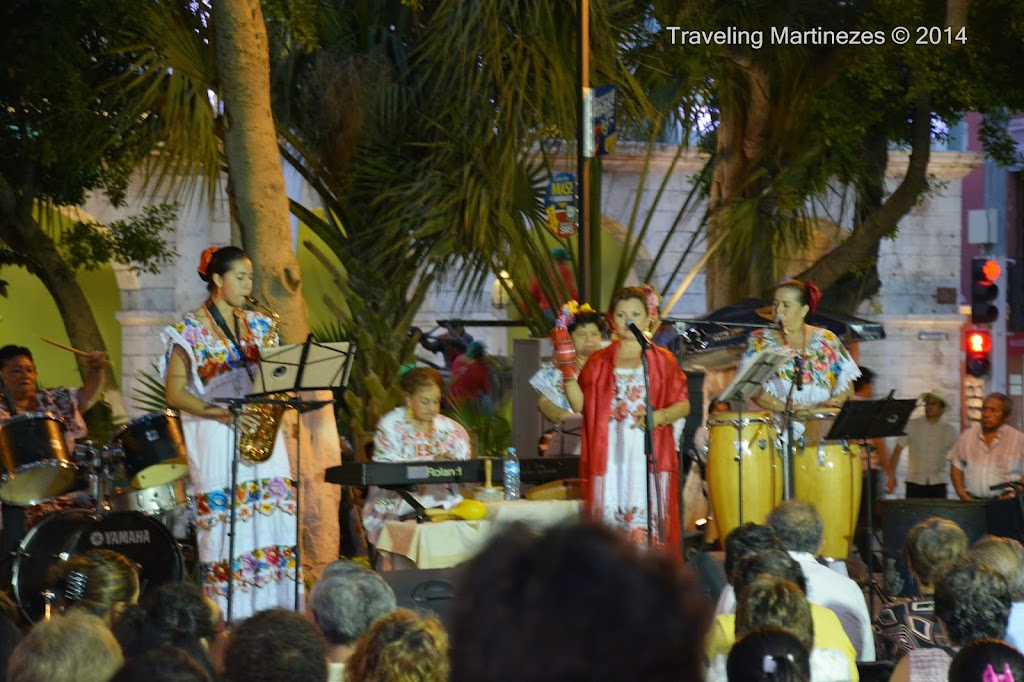

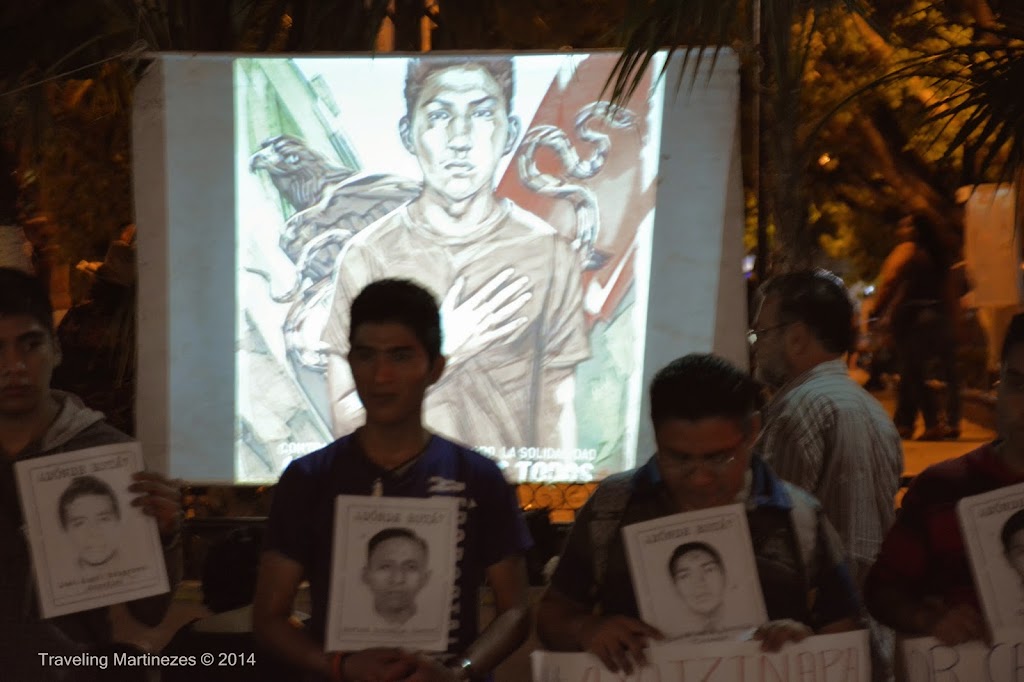
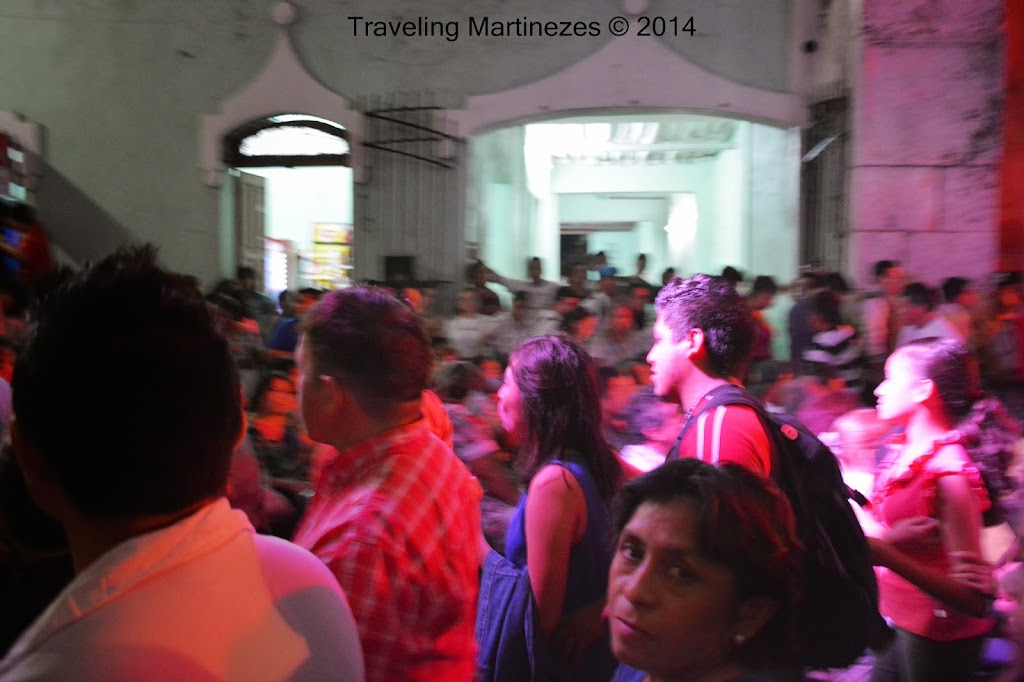
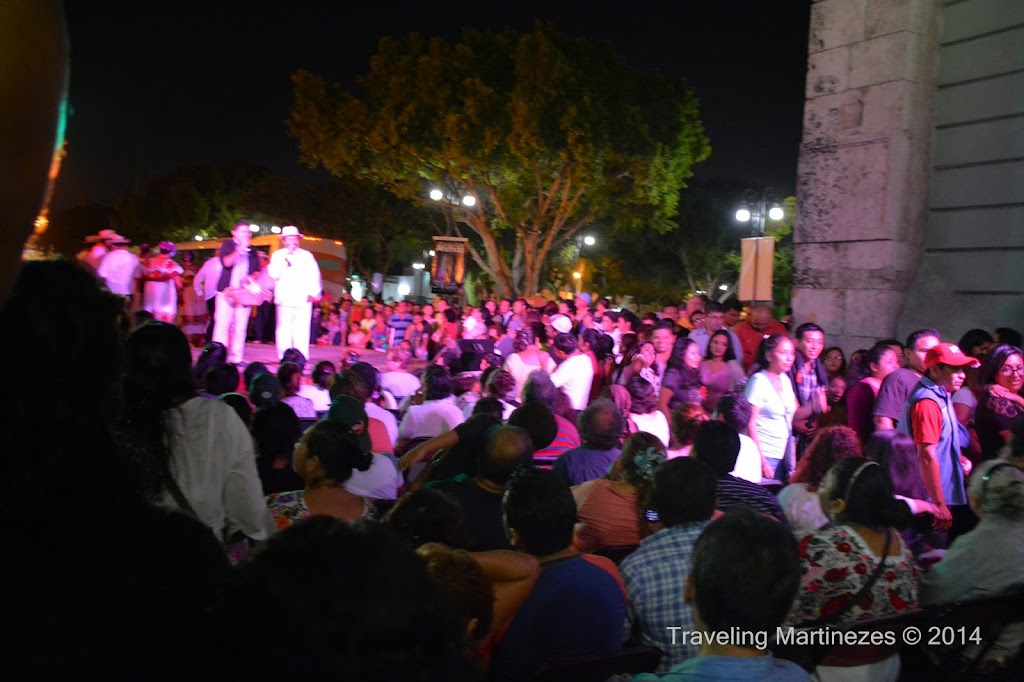
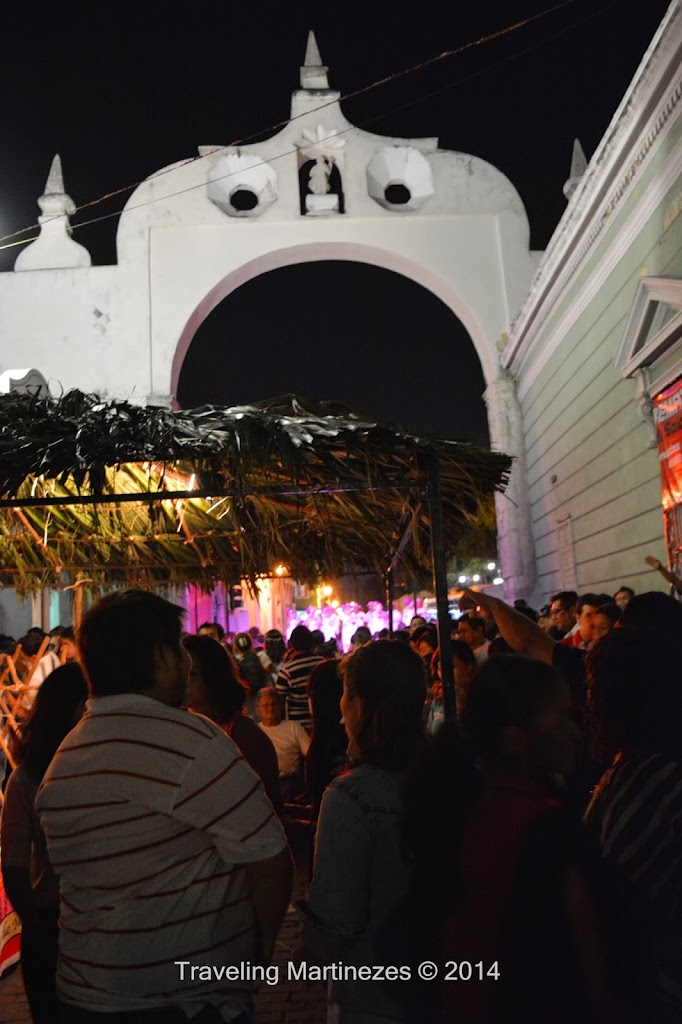
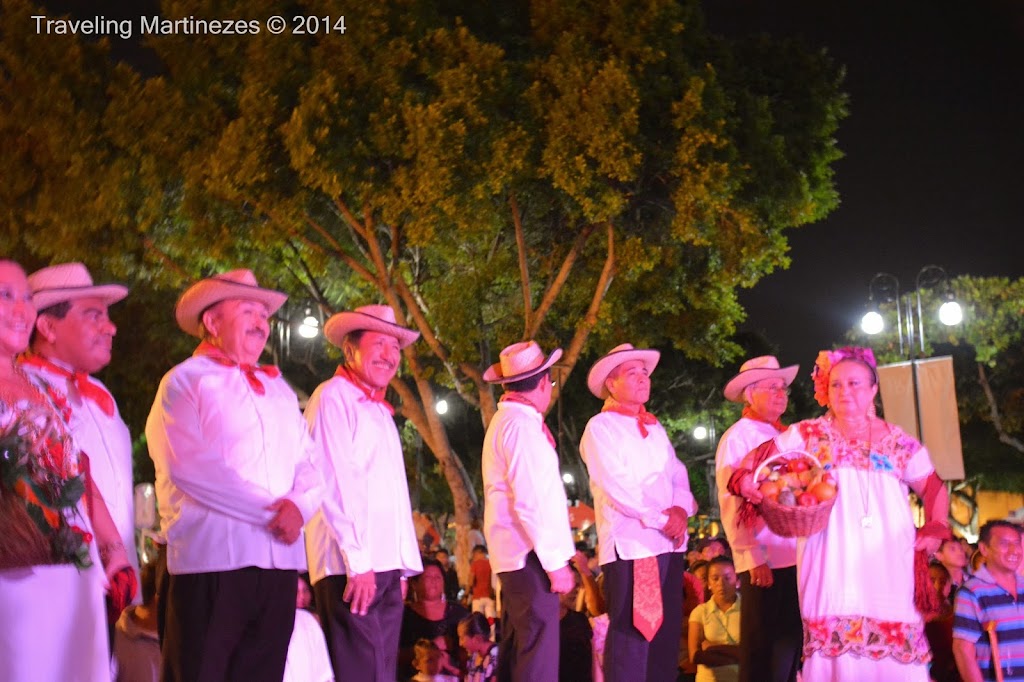
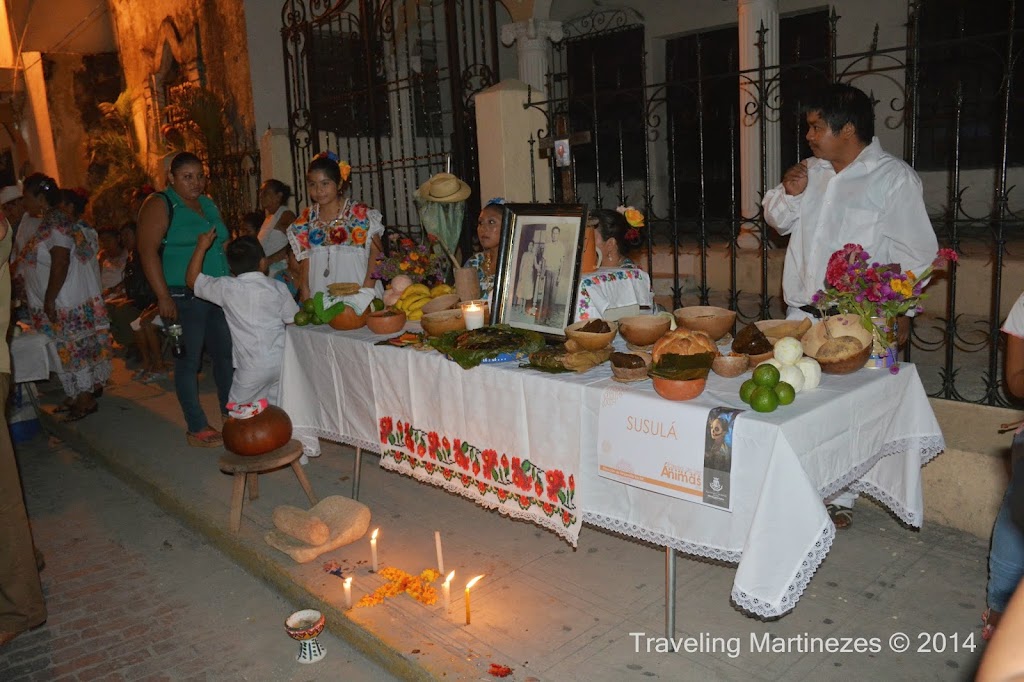
Leave a Reply